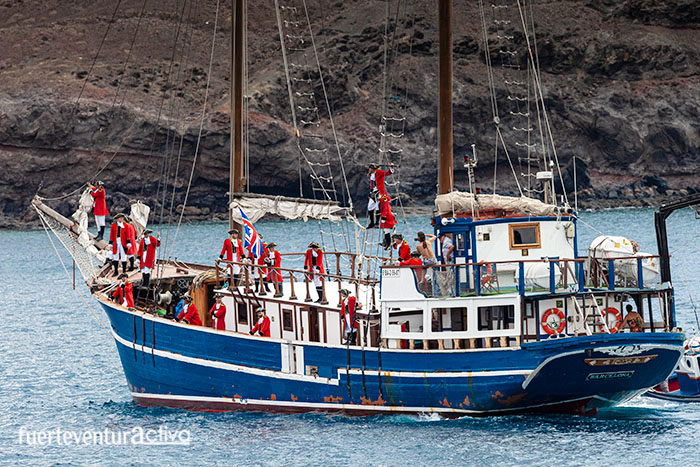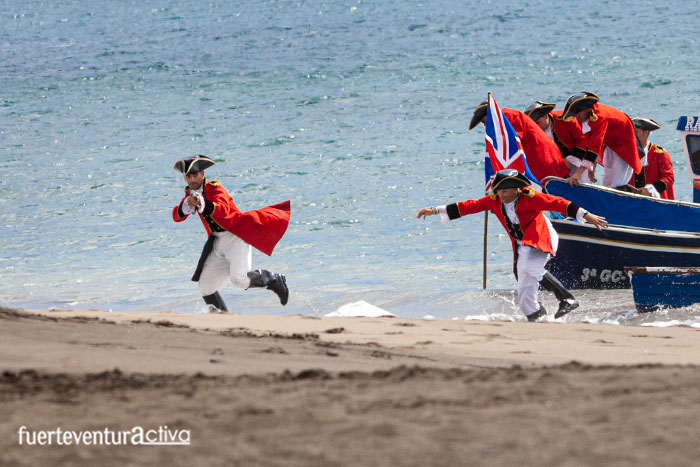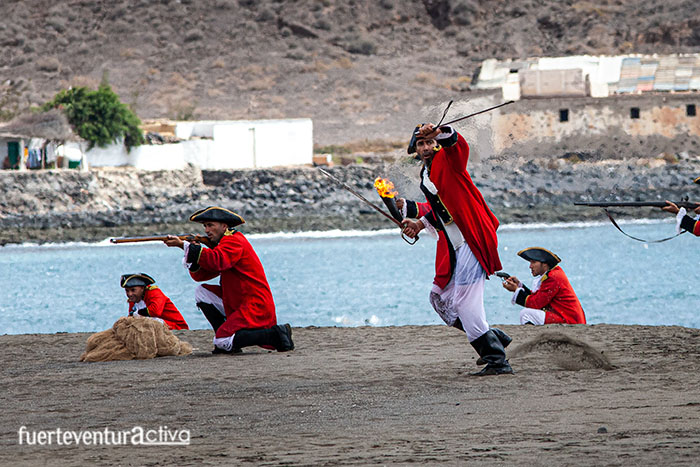FUERTEVENTURA WITH CHILDREN, What to see in Fuerteventura ?
Historical representations in Fuerteventura – The Battle of Tamasite
Historical representations are highly valued activities by tourists and locals
These events are not intended to be a true reflection of our past, . In addition, the town that hosts an event of this nature usually chooses the episode in which it wins.
Historical representations are made rather as a way of bringing history closer, more vivid and more unforgettable to the residents of the town and also to foreigners.
These events are a real economic and tourist boost for the towns that organize them. For this reason, for some decades, an endless number of historical recreations have been taking place throughout Spain. In addition to promoting a material or immaterial heritage milestone, these festivals, in which a large part of the local people participate, defend their cultural values, making known what happened in a specific era and recreating those times of splendor.
In most of the islands of the Canary Archipelago some historical event is represented. In Fuerteventura, for several years now, the battles of Tamasite and El Cuchillete, which occurred at the end of 1740, have been recreated. In both, the Majoreros emerged victorious.
Battles of Tamasite and El Cuchillete

In October 1739 England declared war on Spain. This was a purely commercial war, in which the right to trade slaves in America was disputed. This war situation was called “Jenkins’ Ear War” (The right to trade in America with 4,800 slaves per year for thirty years).
Months later, various English ships led by corsairs prowled the Canary waters. They made several incursions into our waters and seized every ship that crossed their path. The corsairs were not satisfied only with the loot from the ships they seized but, knowing that the Majorera coasts were unprotected, they raided the ports of Fuerteventura, especially those in the south.
English corsairs disembark in Fuerteventura.

In October and November 1740, two important landings took place in Fuerteventura with their respective incursions inland. The Majoreros stood up to them and emerged victorious. We know these warlike confrontations as the Battle of Tamasite and the Battle of the Cuchillete.
English corsairs disembark in Fuerteventura.
In October and November 1740, two important landings took place in Fuerteventura with their respective incursions inland. The Majoreros stood up to them and emerged victorious. We know these warlike confrontations as the Battle of Tamasite and the Battle of the Cuchillete
The preparations to attack the populations of Fuerteventura began months before in America, specifically in Boston. There young people wanting to live new experiences, and veterans with military training, enrolled in sloop-type warships. These ships had the capacity to hold 14 cannons and 75 men. The crew members would work as corsairs for the English colony. The newspapers of the time advertised the job offer as a great adventure to “go in search of Spaniards”.
On the morning of October 13, 1740, the ship Vernon, captained by the corsair Willes, landed on the beach of Gran Tarajal. 50 men went ashore and looted the Tuineje area.
The majoreros armed with stones and sticks, and led by Lieutenant Colonel Sánchez Umpiérrez, decided to confront the assailants. This battle is known as the battle of “El Cuchillete”. In it, the English lost 33 soldiers, the rest were captured and taken to Tenerife. On the Fuerteventura side, there were only three deaths: Agustín de Armas, Diego Chrisóstomo and Juan de Oliva.

After the October victory, the Majorero militias were put on alert and prepared defensive elements, in order to repel any other invasion attempt. But the calm did not last long. On November 24, 1740, another English ship managed to reach the coast of Gran Tarajal. It was the Sant Andreu and was captained by the corsair Davidson. The warship came from Jamaica.
This time 56 men landed. The invaders traveled, effortlessly, the 14 kilometers that separate the Gran Tarajal beach from the town of Tuineje. They tried to loot the town again, but the residents of Fuerteventura were warned. When the English arrived the town was empty, and after looting it they were ambushed by the Majorero militias who, this time, did have a firearm seized from the English in the previous conflict. The confrontation was fought in an open field, in the Llano del Florido, where the 55 Englishmen were left lying on the Tuineje field. This was the famous “Battle of Tamasite”.

Every year, and in a playful way, the victories of October 13 and November 24 are represented as if they were one. The event is known as the Battle of Tamasite. It is commemorated within the Sworn Festivities of Tuineje, declared BlC, of National and Regional Tourist Interest.
The historical representations are carried out both in some of the places in the municipality of Tuineje, where the contests took place, and in various locations on the island.
However, the landing at Gran Tarajal Beach, which is usually held every October 12, at noon, is the part that arouses the most expectation and the one that attracts the most public. More than 200 extras actively participate in this dramatization.
The following day, in the town of Tuineje, the victory of the Majoreros over the English corsairs is represented.
So, if you are in Fuerteventura during the first fortnight of October, do not forget to attend this event and learn about our history
Fuerteventura4


